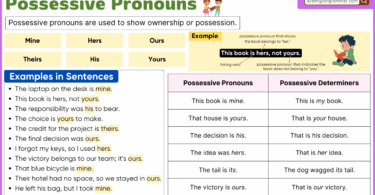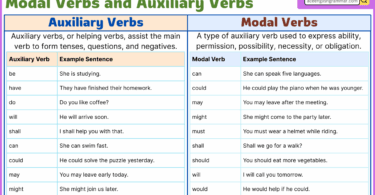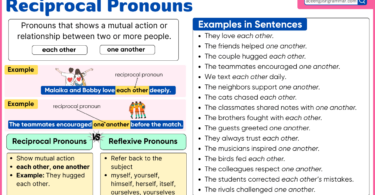Clauses are a group of words that contain a subject and a predicate. In English, there are various types of clauses, and the adverbial clause is one of them. As the name suggests, an adverbial clause performs the same function as an adverb in a sentence. It modifies a verb, an adjective, or another adverb in the main clause. Understanding adverbial clauses is crucial for creating well-structured and grammatically correct sentences in English.
Adverb: A word that modifies or describes a verb, adjective, or another adverb. It often answers questions like how, when, where, or to what extent.
Clause: A group of words containing a subject and a verb.
Table of Contents
What Is an Adverbial Clause?
An adverbial clause is a dependent clause that functions as an adverb, modifying a verb, adjective, or another adverb in a sentence. It provides information about when, where, why, how, to what extent, or under what condition an action happens.
- If you study hard, you will pass the exam.
In this sentence the adverbial clause “If you study hard” sets a condition under which the main action (passing the exam) will occur.
- I’ll call you when I get home.
Here clause “when I get home” provides information about when the action (calling) will occur. It specifies the time of the action, indicating that the call will happen at the moment the speaker arrives home.
How to Identify Adverbial Clauses:
- Subordination:
- Adverbial clauses are introduced by subordinating conjunctions, such as “when,” “while,” “although,” “because,” and many more.
- Dependence:
- Adverbial clauses cannot stand alone as complete sentences. They depend on the main clause for context and meaning.
- Modifying Action:
- These clauses modify the action of the main clause, providing additional information about when, where, why, or how the action occurs.
How to Use Adverb Clauses?
Using adverbial clauses effectively involves understanding their purpose, structure, and placement within a sentence. Here are some guidelines on how to use them appropriately in your writing or speech:
Function in a Sentence
As mentioned earlier adverbial clauses are used to provide additional information about actions in a sentence. They often answer questions like “When?” “Where?” “Why?” “How?” or “Under what conditions?” They add depth and context to sentences and can significantly affect the meaning of the main clause.
Identify the Purpose
Determine the specific type of adverbial clause you need based on the information you want to convey. Is it about time, place, manner, reason, condition, or purpose? Each type serves a different function, so choose the appropriate one for your context.
Understand Clause Structure
Adverbial clauses begin with a subordinating conjunction (e.g., “when,” “if,” “because”) and contain a subject and a verb. The subordinating conjunction connects the adverbial clause to the main clause.
Example:
- If you study hard (adverbial clause), you will pass the exam (main clause).
Position the Adverbial Clause
They can appear at the beginning, middle, or end of a sentence, depending on the specific subordinating conjunction used and the intended emphasis. When they begin a sentence, they are often followed by a comma.
Example:
- Beginning: After I finish my work, I will go to the gym.
- Middle: I will go to the gym when I finish my work.
- End: I will go to the gym after I finish my work.
Punctuate Correctly
Punctuation: When adverbial clauses begin a sentence, they are often followed by a comma. However, when they appear at the end of a sentence, they usually don’t require a comma unless they are essential for clarity.
Example:
- Before the sun sets, we’ll be home. (comma)
- We’ll be home before the sun sets. (no comma)
Choose the Right Subordinating Conjunction
Use an appropriate subordinating conjunction like “when,” “where,” “how,” “because,” “if,” or “so that” to introduce the adverbial clause.
Example:
- I’ll call you when I arrive.

Adverbial Clauses with Types and Examples
Common Subordinating Conjunctions:
- Time: when, while, before, after, since, until, as soon as
- Place: where, wherever, everywhere
- Reason: because, since, as, so that
- Condition: if, unless, even if, whether
- Purpose: so that, in order that
- Result: so that, such…that
- Contrast: although, though, even though, whereas
Structure of Adverbial Clauses:
Adverbial clauses have a specific structure:
- Subordinating conjunction + Subject + Verb
Subordinating Conjunction: The word that connects the adverbial clause to the main clause. It introduces the relationship between the two clauses.
- Example: Because it was raining, we stayed indoors.
Subject: The one performing the action in the adverbial clause.
- Example: When he arrives, tell him I’m busy.
Verb: The action or state of being performed by the subject.
- Example: We’ll go swimming if the weather is good.
Types of Adverbial Clauses
Adverbial clauses can be categorized based on the type of information they provide and their relationship to the main clause. Here are some common types:
1. Time Adverbial Clauses:
- Function: Indicate when an action takes place.
- Example: “Before she goes to bed, she reads a book.”
2. Place Adverbial Clauses:
- Function: Describe the location or place of an action.
- Example: “Wherever they go, their dog follows.”
3. Manner Adverbial Clauses:
- Function: Explain how an action is performed.
- Example: “He ate the cake as if he hadn’t eaten in days.”
4. Reason Adverbial Clauses:
- Function: Explain the cause or reason behind an action.
- Example: “Because it’s Monday, the school starts early.”
5. Condition Adverbial Clauses:
- Function: Set conditions under which an action occurs.
- Example: “If you finish your homework, you can go out to play.”
6. Purpose Adverbial Clauses:
- Function: Specify the purpose or goal of an action.
- Example: “She studies late at night so that she can pass the exam.”
7. Contrast Adverbial Clauses:
- Function: Highlight a contrast or difference in information.
- Example: “Although it’s sunny, bring an umbrella just in case.”
8. Result Adverbial Clauses:
- Function: Indicate the consequence or result of an action.
- Example: “She danced so gracefully that everyone applauded.”
9. Concession Adverbial Clauses:
- Function: Acknowledge a point against the main clause.
- Example: “Even though it’s late, I will finish this article.”
10. Comparison Adverbial Clauses:
- Function: Compare the action in the main clause to another.
- Example: “She runs faster than her brother does.”
11. Proportion Adverbial Clauses:
- Function: Express proportion or degree in relation to the main clause.
- Example: “The more you practice, the better you get.”
12. Time Sequence Adverbial Clauses:
- Function: Show the order or sequence of actions.
- Example: “After she finished her work, she went for a walk.”
Functions of Adverbial Clauses:
- Adding Detail:
- Adverbial clauses provide additional information, adding depth and detail to a sentence.
- Modifying Verbs:
- They modify verbs by explaining how, when, where, or why an action occurs.
- Creating Relationships:
- Adverbial clauses establish relationships between different parts of a sentence, enhancing coherence.
- Expressing Conditions:
- Condition adverbial clauses set conditions under which actions take place, introducing a sense of contingency.
- Showing Consequences:
- Result adverbial clauses highlight the consequences or outcomes of actions, offering a cause-and-effect relationship.
Adverbial Clauses vs Adverbial Phrases
Although they both modify verbs, adjectives, or adverbs, but they differ in structure. Adverbial clauses are groups of words containing a subject and verb that act as adverbs within a sentence. They’re introduced by subordinating conjunctions (e.g., “when,” “if,” and “because”). Adverbial phrases, on the other hand, are groups of words that function as adverbs but lack a subject-verb relationship. Instead, they are made up of prepositions and their objects, adverbs, or other modifiers. Adverbial clauses provide more information and can stand alone as sentences, while adverbial phrases offer more concise details and cannot stand alone. For example, “Because he was tired” is an adverbial clause, while “In the morning” is an adverbial phrase.
Examples of Adverbial Clauses
- Before he leaves, he always checks his email. (Time)
- Because it’s Monday, the school starts early. (Reason)
- When the alarm rings, it’s time to wake up. (Time)
- Wherever she travels, she takes photos. (Place)
- He ate the cake as if he hadn’t eaten in days. (Manner)
- Because it’s a weekend, the park is crowded. (Reason)
- He exercises daily so that he stays healthy. (Purpose)
- Although it’s cold, she refuses to wear a coat. (Contrast)
- Before the movie starts, grab some popcorn. (Time)
- Wherever the wind blows, the leaves follow. (Place)
- She paints with such precision as if using a brush. (Manner)
- Because it’s a holiday, the kids are playing outside. (Reason)
- If the alarm goes off, evacuate the building. (Condition)
- I study every day so that I can learn new things. (Purpose)
- She worked so efficiently that she finished early. (Result)
- When the bell rings, it’s time for recess. (Time)
- He sings in the car as if he’s on a stage. (Manner)
- Because it’s a weekend, the traffic is lighter. (Reason)
- If it’s sunny, we’ll have a picnic in the park. (Condition)
- She studies late at night so that she can pass the exam. (Purpose)
FAQs
Q1: What is an adverbial clause?
An adverbial clause is a group of words that functions as an adverb in a sentence. It provides information about how, when, where, why, or to what extent an action in the main clause is performed.
Q2: What’s the difference between an adverbial clause and an adverbial phrase?
An adverbial clause is a group of words with a subject and a verb that functions as an adverb. An adverbial phrase, on the other hand, is a group of words that functions as an adverb but lacks a subject and a verb. For example, “in the morning” is an adverbial phrase, while “when I wake up” is an adverbial clause.
Q3: How do you punctuate adverbial clauses?
Adverbial clauses are often separated from the main clause by a comma when they appear at the beginning of a sentence. However, if it follows the main clause and is not essential to the sentence’s meaning, it can be separated by a comma as well.
Q4: What are the common types of adverbial clauses?
They can be categorized based on their function. Some common types include time clauses (when, while, as soon as), place clauses (where), manner clauses (how), condition clauses (if, unless), purpose clauses (so that, in order that), and reason clauses (because, since).
Q5: Can an adverbial clause stand alone as a sentence?
No, they cannot stand alone as a complete sentence because it is dependent on a main clause to provide its meaning. It needs the main clause to make sense.
Q6: What are some examples of adverbial clauses in sentences?
- Because it was raining, we stayed indoors. (Reason)
- She sang beautifully although she was nervous. (Contrast)
- He’ll call you when he gets home. (Time)
- I went to the store where I usually buy groceries. (Place)
- I’ll call you if I have any questions. (Condition)
You May Also Like:



